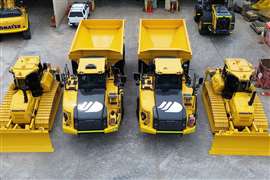Wheels or tracks for compact loaders? Murray Pollok reports.
28 September 2010

Which is best for rental companies - wheeled or tracked tool carriers/skid steers? The answer depends on the application, the customer, and the budget. Murray Pollok reports.
Tracked loaders are considerably more costly than conventional skid steers, but that hasn't put off rental companies from investing in them.
One example is Outiloc 33, a small French rental company that started business in early 2009. Based in the village of Le Barp near Bordeaux, it runs a Bobcat T110 compact tracked loader that is very much in demand on housing developments and individual homes being built in the area.
The company reports that landscapers in particular like the machine because it is very easy to transport and ideal for working in narrow and hard to access areas. The low ground pressure offered by the tracks (0.32 kg/cm²) means that it does not damage roads or pavements.
Bobcat reports that Outiloc is not the only French rental company opting to buy the tracked models: Colbert has bought three T110s and Kiloutou has added seven T190 rubber tracked models and three T250 steel tracked machines for grading applications (utilising the high pushing power). In the UK, MTS Group is one rental company that has both tracked and wheeled skid steers from Bobcat in its fleet.
As Bobcat explains it; "Compared to wheeled skid-steer loaders, compact tracked loaders offer a number of features that have attracted rental companies around Europe. For work in soft/muddy ground conditions, a tracked loader has a much lower ground pressure, better stability, more tractive effort and more pushing force."
It is the application that is ultimately the key factor, says JCB; "Historically, wheeled machines have always been the preferred machines for rental. Compact Tracked Loaders cost significantly more, and the rubber tracks and undercarriage system are higher maintenance than wheeled units.
"Ultimately, the applications dictate the need of wheeled versus tracked units. Rental companies must charge higher rental rates on track loaders to be able to obtain a comparable return on investment of wheeled units."
This issue of application is also linked to the types of customer that a rental company has. Kelly Moore, Gehl's product manager for skid steers, compact tracked loaders and compact wheeled loaders, says rental companies need to "closely review their customer base and usage [to determine] whether wheeled or tracked compact loaders would best be rented.
"Skid steer loaders naturally have their highest wear item being in tyres, while on track loaders it will be the rubber tracks. Tyres are considerably less costly as compared to track replacement, so these key factors need to be weighed heavily in decisions on what type of machine to invest for rental fleets.
"As general rule, skid loaders are probably able to be utilized in 80-90% of applications where mud and soft conditions wouldn't prevail, whereas track loaders can be better used in those type of conditions." Ms Moore makes the further point that using tracks on surfaces that will damage the crawlers is a real drawback, since maintenance and replacement costs will be steep.
Italian manufacturer Messersi makes some of the same points; "We have to say there not an absolute answer: it depends on the job you have to do", and highlights the stability of the tracked loaders as being an advantage. It also echoes Kelly Moore's point about the economic life of the crawlers.
Caterpillar says that skid steer loaders are going to be the number one choice for rental companies as they offer the most economical solution to most application needs. "SSLs are very often the utility machine on site, equipped with a bucket and broom for moving materials and cleaning up", says cat, "However many companies are realising the hydraulic potential of these machines and the additional revenue that more specialist work tools can bring. A typical example of this is a skid steer equipped with a cold planer and pick up broom."
The US manufacturer also offers two options of tracked machines - the steel idler, rubber covered steel track system (its CTL models), and the rubber covered idlers full rubber track system (multi terrain loader (MTL)). Cat says the MTL machines are "very suitable for landscaping applications where damage to fragile surfaces must be kept to a minimum", while the CTL units "have a wider application spread and are suitable for general construction applications where soft conditions are being found."
The same wheel or track choice is available at the smaller end of the market with the compact tool carriers offered by companies including Vermeer, Ditch Witch, Toro, Boxer and Kanga (owned by Digga).
Greg Lawrence, marketing product manager for Toro, says tracked units tend to be more popular for compact utility loaders because the tracks distribute the weight of the machine more evenly, leaving less of a footprint, which means the operator can work in a wider range of ground conditions." He says the choice ultimately comes down to personal choice "since both models have their own advantages."
Mr Lawrence points out that there are other important considerations. "Does your customer base have an engine preference?", he asks, "European rental companies tend to prefer diesel engine units, while companies in the US preference my vary depending on their customer base. Professional contractors operating larger equipment will tend to prefer diesel because the majority of their fleet will likely have diesel engines. However, contractors that are operating mowers likely prefer gas engines because the majority of their fleet is comprised of gas units. Homeowners in the US prefer gas because of availability."
The choice between walk-behind and ride-on is another important one on these smaller units. "With most manufacturers, you are forced to choose either a dedicated walk-behind or a dedicated stand-on", says Mr Lawrence, "but Toro doesn't make rental companies choose. Toro offers the TX platform, which gives operators the option of switching between having a ride-on and a walk-behind."
He argues that in the rental industry, having a walk-behind machine is important for novice operators not familiar with operating equipment; "The ability to ‘walk-away' from the machine by not riding on is important and makes inexperienced and newer users more comfortable. However, if a contractor is using the unit all day and covering a lot of ground, a ride-on unit may best fit their needs."
Ground conditions are the key determinant thinks Jon Kuyers, utility products segment manager at Vermeer; "In regions where the ground is sandy or where flotation is needed (soft soils) the track unit would be the machine of choice...The customer will be more productive and more apt to rent again which in turn will provide higher utilisation for the rental store owner. A wheeled unit is best suited for rental on hard surfaces like concrete or asphalt."
Kanga Loaders UK believes it has a competitive advantage in offering its compact loaders with a ‘track over tyre' design. Stuart Coar, national sales manager
at Kanga Loaders UK, says; "Not only do Kanga offer the largest range of stand on mini skid steer loaders in class, but our tracked machines feature an ingenious and unique ‘track over tyre' design, whereby the unit's tracks locate over conventional air filled tyres. This innovation provides smoother, more efficient, more forgiving performance, for a comparatively negligible price differential.
In fact, Kanga sells more tracked models than wheeled to its rental customers in Europe because of the flexibility they offer; "This we believe to be a fundamentally important consideration given the seasonal variances in climate and ground conditions throughout Europe, and accounts for why the majority of our sales to European rental companies are of our tracked units."
Of course, each manufacturer believes its own machines offer particular benefits. For example, JCB points to its single Monoboom, side entry design, which is definitely the major differentiator for its range of wheeled and tracked models; "The operator does not have to enter and exit through the front of the machine, over large, cumbersome, or wet and muddy attachments", says the company, "This...design also provides industry leading near 360 degree visibility. This improved visibility allows the operator to be more productive, improving productivity and job site safety." The recently announced alliance between JCB and Volvo will see Volvo selling JCB-built monoboom models.
Kelly Moore at Gehl - which offers both tracked and wheeled skid steers - says it is the sheer range of products available is a major benefit; "There are many models to suit most any application, from a subcompact, 24 hp, less than 3 m wide unit, to the popular 612 and 748 kg mid-size loaders, to the huge 99 hp, 1.8 t capacity unit."
The company also offers a number of control options. "A key operating feature is the use of Gehl ‘T-Bar' drive controls that intuitively allow any operator the ease of driving the machine with one's left hand, while the lift and tilt functions are done with the right hand. The only foot pedals used are for powering auxiliary hydraulics and also featuring a standard equipment foot throttle." Hand/foot style controls are also available at no extra cost.
Caterpillar says that it recognises that "machines going out from rental companies are not likely to be operated by experienced drivers. Therefore considerable design time was allocated to the cab and controls to make them intuitive, logical and easy for the unskilled operator to learn."
In terms of serviceability, Cat has "grouped all the daily service points inside the rear door of the machine for easy access, recognising that if they are easily accessed daily service check are more likely to get done."
Also offering both wheeled and tracked models is Vermeer, which also highlights simplified controls that "provide a quick learning curve for novice operators; safe, comfortable operating platforms which minimize operator fatigue; and provide excellent visibility to the work area."
Stuart Coar at Kanga says the design principle of the ride-on, multi-tasking mini loader "permits many tasks historically performed by single disciplined machines or hand labour alone, to be completed in less time, more safely and with consummate ease. An undoubted key to the success of the mini loader is its multi-tasking abilities, which offers the potential of all year round hire, unlike many single disciplined machines which often have a degree of seasonality and thereby limited return on investment."
Greg Lawrence at Toro makes the same point about the versatility of the compact loader, and says this is particularly relevant now and says the reason that "many rental stores have added compact utility loaders to their equipment fleet is the cost of having a yard full of dedicated pieces of equipment - especially in today's economic conditions.
"Rental stores are replacing application-specific equipment that is not regularly rented with a compact utility loader and attachments. This combination eliminates the waste of owning equipment that isn't maximizing their return-on-investment."
Meanwhile, Italy's Messersi sums up the strengths of its loaders as follows: "Good compromise between price and quality, fast maintenance, easy guidance (axial pumps, joysticks and hydraulic motors transmission without chain) and really good performance (big engines with hydraulic fan)."
Of course there are many more suppliers to choose from, including Case, New Holland, Terex Construction (which acquired the ASV tracked loader line a few years back), Komatsu, Hyundai, Wacker Neuson, Mustang and Italy's IHIMER.
In addition to these machines, Chinese suppliers are becoming more active on international markets, with both Sunward and LiuGong offering skid steers. LiuGong, for example, offers five skid steer models - including the recently launched 365A model - while Sunward's range includes five wheeled and three tracked models.
In the end, the question over whether to opt for tracked or wheeled simply leads to other questions over the application and the type of customer. In many fleets, as with Kiloutou in France, there should be room for both.
STAY CONNECTED



Receive the information you need when you need it through our world-leading magazines, newsletters and daily briefings.
CONNECT WITH THE TEAM











